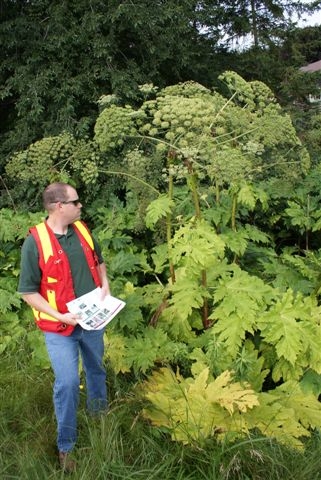Giant Hogweed
Giant Hogweed is a poisonous, invasive plant that can cause skin rashes, burns and blisters. If you suspect you’ve found Giant Hogweed, do not touch any part of the plant.

Appearance
Giant Hogweed is an invasive plant that looks similar to cow parsnip or Queen Anne's Lace. Its flower stalks can grow up to 20 feet tall.
For the first few years of its life, a Giant Hogweed plant will not produce stalks or flowers, but its large, sharply-toothed leaves can grow up to five feet wide. The stem of the plant is hollow with dark reddish-purple spots and coarse white hairs.
Health Risk
Giant Hogweed can be a serious health risk. If you see Giant Hogweed, do not touch it. The plant’s sap can make skin especially sensitive to sunlight, causing a rash and blistering.
Pets can also carry the Giant Hogweed toxins on their fur. Be cautious about where your pets go, especially in areas where Giant Hogweed has been spotted.
Symptoms
A reaction to sunlight because of exposure to Giant Hogweed sap can occur up to 48 hours after contact and result in severe burns and blisters. The blisters can develop into purple and black scars. Depending on sensitivity, effects can last for months and skin can remain sensitive to UV light for years.
Sap contact with the eyes can sometimes cause temporary blindness. In rare cases it can result in permanent blindness.
Avoid contact with any part of the Giant Hogweed plant at all times.
If you Have Come in Contact with Giant Hogweed
If you think you have come in contact with Giant Hogweed:
- Wash affected areas immediately
- Keep the affected areas out of the sun
- Seek medical attention
If you Find Giant Hogweed on Your Property
Be careful not to touch the plant.
Hire a professional pesticide/herbicide applicator licensed by the Ontario Ministry of Environment to remove the plants and dispose of them safely.
If you Find Giant Hogweed in a Public Space
Immediately notify your local municipality or local Conservation Authority.


